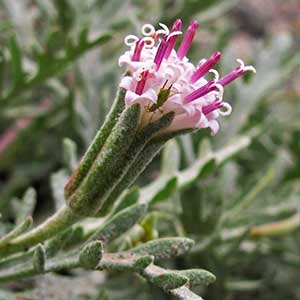Chaenactis thompsonii
Chaenactis sect. Macrocarphus
Thompson's pincushion
mostly 5–15+, ascending to erect.
1–25+, prostrate to erect;
branches mainly proximal.
mostly cauline, 2–5 cm;
largest blades ± elliptic, ± plane, 1-pinnately lobed;
lobes mostly 2–5 pairs, remote, ± plane.
largest blades deltate, elliptic, linear, or ovate, (0–)1–2-pinnately or -subpalmately lobed, gland-dotted beneath indument.
ascending to erect, 2–5 cm.
prostrate to erect.
± obconic.
7–9 mm.
white to pinkish or cream, actinomorphic, ± equal.
longest (10–)12–15 mm;
outer closely lanuginose, not stipitate-glandular, apices erect, ± rigid.
outer ± blunt.
mostly 1–3 per stem.
discoid.
7–9 mm (eglandular);
pappi: longest scales 3.5–5 mm.
± terete;
pappi of (8–)10–20 scales in 2–4 equal or gradually unequal series.
= 6.
Chaenactis thompsonii
Chaenactis sect. Macrocarphus
Of conservation concern.
Chaenactis thompsonii appears to be sister to C. evermannii; it is known from the mountains of central and northwestern Washington. The similar habits of C. thompsonii and C. ramosa (= C. douglasii var. douglasii) appear to result from convergent evolution in the distinctive habitat of their type localities (Wenatchee Mountains), not from a close genetic relationship as suggested by Cronquist.
(Discussion copyrighted by Flora of North America; reprinted with permission.)
Species 8 (8 in the flora).
Species of sect. Macrocarphus occur mainly in montane to alpine habitats; all except Chaenactis douglasii are narrowly distributed. With C. douglasii here broadly defined, all the species of sect. Macrocarphus are sharply distinct.
(Discussion copyrighted by Flora of North America; reprinted with permission.)
1. Leaves ± cauline and, often, basal; plants not or scarcely cespitose, not matted; heads (1–)2–25+ per stem | → 2 |
1. Leaves ± basal; plants cespitose or ± matted; heads 1(–3) per stem | → 5 |
2. Subshrubs (usually); proximal indument (especially stems) persistent, whitish, densely lanuginose or pannose; largest leaf blades deltate to ovate, ± plane (California) | → 3 |
2. Biennials or perennials (rarely slightly woody or flowering first year); proximal indument ± thinning with age, grayish, arachnoid to ± lanuginose; largest leaf blades ± elliptic or lanceolate to ovate, plane or ± 3-dimensional | → 4 |
3. Phyllaries: longest 10–13 mm, outer predominantly arachnoid to closely lanuginose (sparsely, if at all, stipitate-glandular) | C. parishii |
3. Phyllaries: longest 14–18 mm, outer predominantly stipitate-glandular (other indument none or sparse) | C. suffrutescens |
4. Outer phyllaries usually densely, sometimes sparsely or obscurely, stipitate-glandular and, often, arachnoid, lanuginose, and/or villous; largest leaf blades ± 3-dimensional, usually 2-pinnately lobed, primary lobes ± congested, ultimate lobes ± involute and/or twisted | C. douglasii |
4. Outer phyllaries closely lanuginose, not stipitate-glandular; largest leaf blades ± plane, 1-pinnately lobed, lobes remote, ± plane (Washington) | C. thompsonii |
5. Outer phyllaries predominantly arachnoid, sericeous, or ± lanuginose (sparsely, if at all, stipitate-glandular) | → 6 |
5. Outer phyllaries predominantly or evidently stipitate-glandular (other indument none, sparse, or ± arachnoid) | → 8 |
6. Cypselae sparsely glandular amidst other indument; largest leaf blades 2-pinnately lobed (± 3-dimensional, primary lobes 4–12 pairs, peduncles mostly ascending to erect) | C. douglasii |
6. Cypselae eglandular; largest leaf blades (0–)1(–2)-pinnately or -subpalmately lobed (± plane, and/or primary lobes 0–4 pairs, and/or peduncles mostly prostrate) | → 7 |
7. Longest pappus scales 2.5–4.5 mm (lengths 0.4–0.8 times corollas); leaf blades ± plane; peduncles mostly ascending to erect; Idaho | C. evermannii |
7. Longest pappus scales 5–8 mm (lengths 0.9–1 times corollas); leaf blades ± plane or 3-dimensional; peduncles mostly prostrate; California, Nevada | C. alpigena |
8. Largest leaf blades deltate to ovate, ± plane, ultimate lobes ± plane | → 9 |
8. Largest leaf blades linear-cylindric to ± elliptic or slightly ovate, ± 3-dimensional, ultimate lobes ± involute and/or twisted | → 10 |
9. Plants 2–10(–12) cm; leaves 2.5–5 cm; longest phyllaries 9–12(–14) mm; corol-las 5.5–8 mm; longest pappus scales 3–5 mm | C. nevadensis |
9. Plants (10–)25–45(–60) cm; leaves 5–10 cm; longest phyllaries 14–18 mm; corollas 8.5–10 mm; longest pappus scales 7–9 mm | C. suffrutescens |
10. Largest leaf blades ± elliptic to slightly ovate, primary lobes (4–)5–9(–12) pairs, ± congested, scarcely imbricate; not s California | C. douglasii |
10. Largest leaf blades linear-cylindric to ± fusiform, primary lobes (7–)10–18+ pairs, ± imbricate; s California | C. santolinoides |


